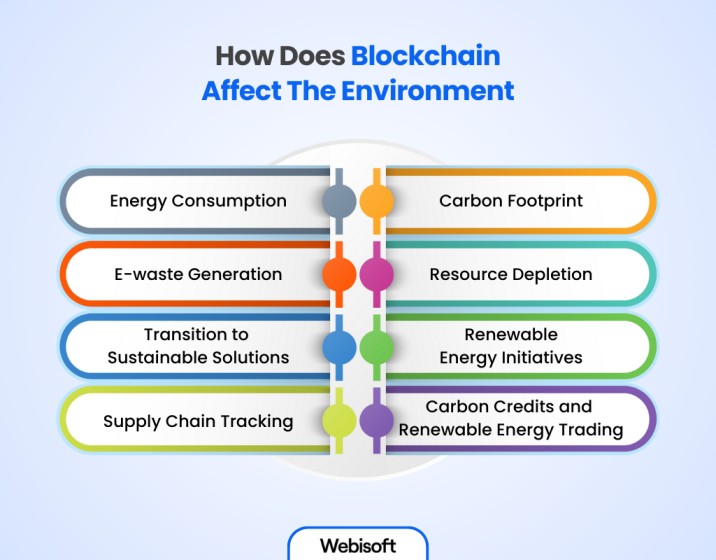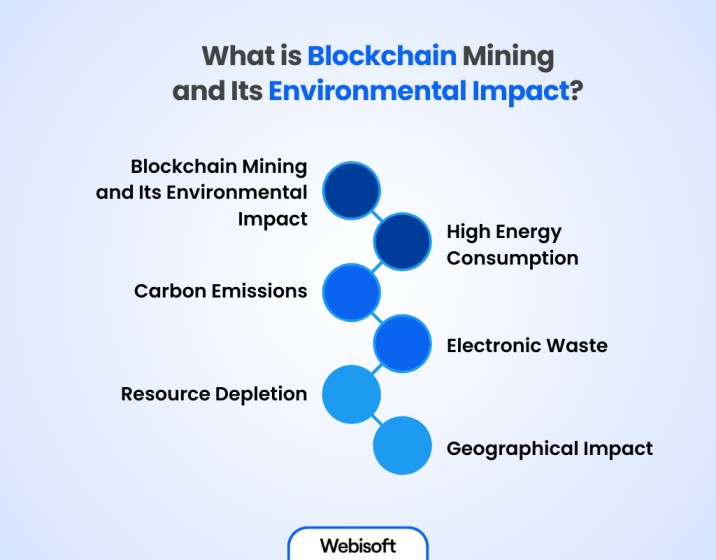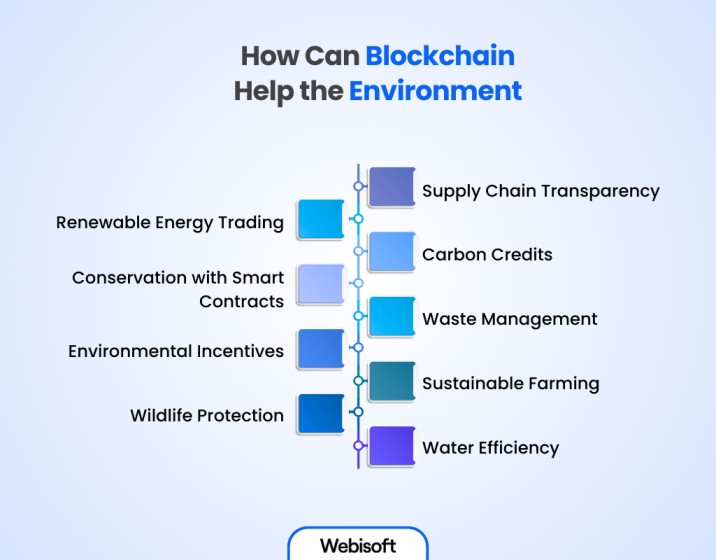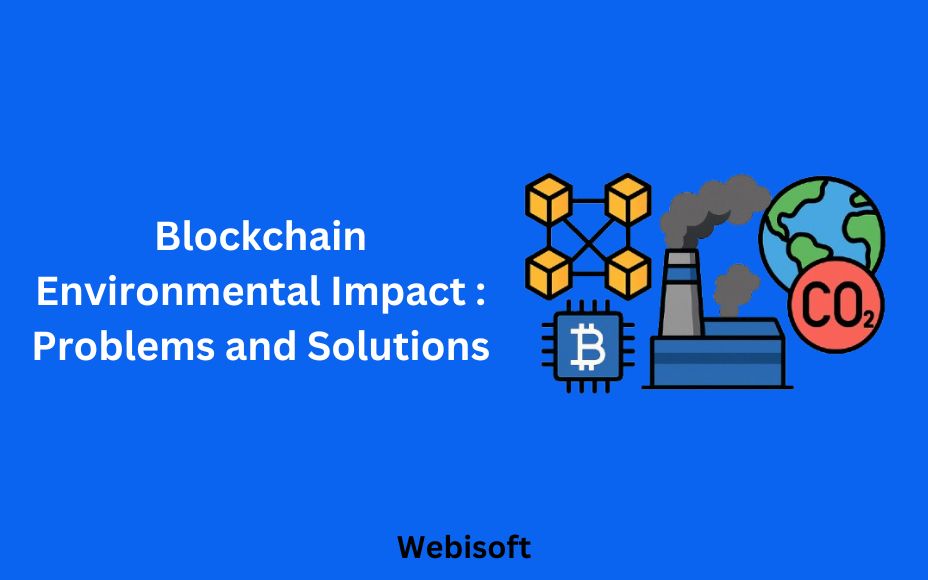Did you know that blockchain technology alone uses a whopping 0.5% of the world’s electricity? This is because of its energy-intensive processes for verifying transactions and creating new blocks, which significantly contribute to climate change.
But how does blockchain environmental impact affect us?
Blockchain technology contributes to a large carbon footprint because its process for verifying transactions and creating new blocks requires a lot of energy. This energy use results in significant greenhouse gas emissions that contribute to climate change.
But there’s more to the story. Blockchain also has the potential to contribute positively to environmental protection. Join us as we explore its impact, prospects, and how it can help the environment in this article. Let’s dive in!
Contents
- 1 What is Blockchain Technology?
- 2 How Does Blockchain Affect The Environment
- 3 What is Blockchain Mining and Its Environmental Impact?
- 4 How Can Blockchain Help the Environment
- 5 Conclusion
- 6 FAQs
- 6.1 Is blockchain environmentally friendly?
- 6.2 Are there specific regions where blockchain’s environmental impact is more pronounced?
- 6.3 Can blockchain technology assist in reducing plastic pollution?
- 6.4 What role does blockchain play in climate change adaptation and mitigation?
- 6.5 Why is blockchain bad for the environment?
What is Blockchain Technology?
Blockchain technology is a decentralized and distributed digital ledger system that records transactions across multiple computers. Each transaction is grouped into a block, and these blocks are linked together in a chain, hence the term “Blockchain.”
Enterprise blockchain provides transparency, security, and immutability, making it a powerful tool for various industries. Transactions on the blockchain are verified by a network of participants, eliminating the need for intermediaries and ensuring trust in the system.
Blockchain has gained recognition primarily for its role in cryptocurrencies like Bitcoin. However, its applications extend to supply chain management, voting systems, smart contracts, and more.
How Does Blockchain Affect The Environment

Blockchain has some environmental concerns. Let’s explore some of the environmental impact of blockchain:
Energy Consumption
Blockchain mining, especially in the case of cryptocurrencies like Bitcoin and Ethereum, relies on the energy-intensive “proof-of-work” (PoW) consensus mechanism. Businesses looking for efficient mining setups often consider bitcoin node solutions to optimize operations.
Miners compete to solve complex mathematical puzzles, which require massive computational power and, subsequently, a significant amount of electricity. This energy consumption is often derived from non-renewable sources, contributing to the strain on energy grids.
Carbon Footprint
The extensive energy consumption in blockchain mining leads to a substantial carbon footprint. Most mining operations use electricity generated from fossil fuels, such as coal and natural gas.
As a result, the carbon emissions associated with blockchain technology have become a significant contributor to greenhouse gas emissions. This, in turn, worsens global warming and climate change concerns.
E-waste Generation
The hardware used for blockchain mining, known as mining rigs or ASICs (Application-Specific Integrated Circuits), has a limited lifespan. When newer and more efficient hardware becomes available, the older mining equipment becomes outdated and is usually thrown away.
This contributes to electronic waste (e-waste) generation, adding to the already substantial global e-waste issue.
Resource Depletion
The production of mining equipment uses up valuable resources. It includes metals and rare earth elements, which are limited in supply and often require energy-intensive mining methods. This extraction and depletion of these resources for manufacturing mining hardware contribute to blockchain environmental impact.
What is Blockchain Mining and Its Environmental Impact?

Blockchain mining is a fundamental process in blockchain technology that involves the validation and recording of transactions on a blockchain network. Miners, who are participants in the network, use powerful computers to solve complex mathematical puzzles.
These puzzles serve to confirm and group new transactions into blocks, which are then added to the blockchain in chronological order.
Environmental Impact
While this process is vital for the security and functionality of the blockchain, it consumes substantial amounts of electricity and has several environmental implications:
High Energy Consumption
Mining operations require an enormous amount of computational power, which leads to substantial electricity usage. This energy-intensive process significantly increases the carbon footprint, especially since most of the world’s electricity comes from fossil fuels.
Carbon Emissions
The electricity used in mining often comes from non-renewable sources like coal and natural gas, leading to significant greenhouse gas emissions. These emissions worsen climate change and environmental issues.
Electronic Waste
The fast turnover of mining hardware, which quickly becomes outdated, leads to electronic waste. Improper disposal of old mining equipment can create environmental risks.
Resource Depletion
The production of mining hardware requires the extraction of raw materials. This leads to resource reduction and potential environmental damage in mining regions.
Geographical Impact
Mining operations are often located in regions with low electricity costs, which are sometimes areas where electricity generation relies heavily on fossil fuels. This worsens the environmental impact in those particular regions.
How Can Blockchain Help the Environment

Blockchain technology, often criticized for its environmental impact, can also play a role in addressing environmental challenges. Here’s how it can make a positive impact:
Supply Chain Transparency
Blockchain’s transparency allows for a clear view of supply chains, ensuring that products are sourced and manufactured sustainably, which in turn reduces the environmental impact caused by unclear supply chain practices.
This helps consumers to make informed choices, promoting responsible consumption and ultimately lowering the overall environmental footprint of production.
Renewable Energy Trading
Blockchain simplifies the trading of renewable energy certificates (RECs) and enables peer-to-peer renewable energy trading blockchain platforms, driving the adoption of clean energy solutions.. This has the potential to change the energy sector by enabling the adoption of clean and renewable energy sources.
Blockchain facilitates the efficient exchange of RECs, making renewable energy more accessible and affordable. This, in turn, reduces our dependence on fossil fuels and subsequently lowers carbon emissions.
Carbon Credits
Carbon credits allow us to offset carbon emissions by supporting projects that reduce or capture an equivalent amount of greenhouse gasses. Blockchain makes the management and trading of carbon credits easier.
It lets companies openly record and verify their carbon reduction initiatives on a blockchain, ensuring trustworthiness. It also minimizes the chance of double-counting.
Additionally, individuals can purchase carbon offsets directly. It simplifies the process for both individuals and organizations to participate in emissions reduction.
Conservation with Smart Contracts
Smart contracts on the blockchain automate and secure funding for conservation projects when certain conditions are fulfilled. These contracts support initiatives such as reforestation or wildlife protection when specific conservation goals are achieved. This ensures transparency and accountability in environmental efforts.
Waste Management
Blockchain improves waste management by providing real-time tracking and verification of waste disposal and recycling processes. This helps municipalities and organizations optimize waste management practices, reduce inefficiencies, and minimize landfill waste.
This improves waste management effectiveness and reduces the environmental impact associated with improper waste disposal.
Environmental Incentives
Some blockchain projects are looking into the idea of creating environmental credits and rewards in the form of tokens or credits. People and organizations can earn these tokens by adopting eco-friendly practices like saving energy or actively engaging in clean energy projects.
These rewards encourage environmentally conscious actions and play a role in building a more sustainable future.
Sustainable Farming
Blockchain can track and verify sustainable farming practices. By documenting data on crop cultivation methods, pesticide usage, and water management, consumers can make informed choices about their purchases.
At the same time, farmers can optimize their methods for sustainability, reducing the environmental impact of agricultural activities.
Wildlife Protection
Blockchain technology can be used in wildlife conservation to verify and track efforts aimed at protecting endangered species and their habitats. It lets donations for wildlife conservation be recorded transparently on a blockchain. This ensures that resources are used efficiently and directly support conservation projects.
Water Efficiency
Recording transparent and immutable data on water usage through blockchain can help in responsible water management. This is especially important in areas facing water shortage. It promotes efficient water usage, reduces wastage, and contributes to preserving this valuable resource.
Conclusion
In conclusion, we’ve covered in detail the blockchain environmental impact. We’ve discussed the energy-intensive nature of blockchain, its contribution to carbon emissions, and the issue of electronic waste.
However, we’ve also explored its potential to bring about positive changes through transparency, carbon credits, and conservation efforts.
Looking to the future, it’s clear that the blockchain industry needs to prioritize sustainability with a thoughtful Solana blockchain strategy in place. As environmental concerns continue to grow, blockchain can play a crucial role in adopting eco-friendly practices and innovative solutions.
If you’re interested in exploring sustainable blockchain initiatives, contact Webisoft today. Our experts can guide you in utilizing blockchain technology while minimizing its impact on the environment. Together, we can work towards a greener and more sustainable future.
FAQs
Is blockchain environmentally friendly?
No, blockchain isn’t always environmentally friendly due to its high electricity consumption, particularly with cryptocurrencies like Bitcoin. This can increase greenhouse gas emissions, impacting the environment negatively.
Are there specific regions where blockchain’s environmental impact is more pronounced?
Yes, regions with a high concentration of blockchain mining operations tend to experience more significant energy consumption and environmental effects.
Can blockchain technology assist in reducing plastic pollution?
Blockchain can help combat plastic pollution by enabling transparent tracking and tracing of plastic products throughout their lifecycle.
What role does blockchain play in climate change adaptation and mitigation?
Blockchain can support climate change adaptation and mitigation by facilitating carbon credit trading and enhancing transparency in renewable energy markets.
Why is blockchain bad for the environment?
Blockchain can be bad for the environment because it uses a lot of electricity, especially for creating new blocks and verifying transactions. This high energy use often leads to increased greenhouse gas emissions, contributing to climate change.
